

 |
July 3-10, 1982: A Week in Brighton, England |
 |
Return to the Index for 1982 |
|
NOTE: I have a personal entry that come here in time sequence. The page containing this entry requires a password; if you will email me at "website" at "rondougherty dot com" I will send one to you. The link to this personal entry is below:
|
Visits to Lincoln's New Salem and Springfield, Illinois
|
In June, Dennis Haggard had a period where he would be staying in Springfield (his home and the state capital) for a few weeks, so I took the opportunity to go down to Springfield and spend some time with him there. Dennis got a chance to show me where he lived and where he worked; there were other things to see in Springfield, but Dennis wanted to take me up to New Salem, to the "Lincoln's New Salem State Historic Site" which we did the Saturday I was down there.
|
As I said, on Saturday we made a trip up northwest of Springfield about 20 miles towards the town of Petersburg; the State Historic Site is just about five miles south of that town. While we could easily have gone up and back the same day, I thought we might try to find someplace near the site to stay the night.
The weather was pretty nice today, and Dennis and I enjoyed the drive up to the Historic Site. I am driving my Datsun 200SX, the sporty little car that I have had now for four or five months.
|
Lincoln left New Salem for Springfield in 1837, and the village was generally abandoned by about 1840, as other towns developed. In the 1930s, the Civilian Conservation Corps built a historic recreation of New Salem based on its original foundations, establishing a state park commemorating Lincoln and Illinois' frontier history.
|
We basically spent the morning and afternoon just walking around the park, looking at the various structures and reading about them and about Lincoln's life while was here. Our first stop was in a visitor's center, where we were able to learn about the history of New Salem (much of which Dennis already knew).
New Salem was founded in 1828, when James Rutledge and John Camron built a gristmill on the Sangamon River- a mill that we would go over to see a bit later. They surveyed and sold village lots for commercial businesses and homes on the ridge stretching to the west above the mill. Over the first few years of its existence, the town grew rapidly, but after the county seat was located in nearby Petersburg, the village began to shrink and by 1840, it was abandoned. The fact that the Sangamon River was not well-suited for steamboat travel was also a reason for the town's decline.
In 1831, when Abraham Lincoln's father, Thomas, relocated the family from Indiana to a new homestead in Coles County, Illinois, 22-year-old Lincoln struck out on his own. Lincoln arrived in New Salem by way of flatboat and he remained in the village for about six years. During his stay, Lincoln earned a living as a shopkeeper, soldier in the Black Hawk War, general store owner, postmaster, land surveyor, and rail splitter, as well as doing odd jobs around the village. As far as historians know, Lincoln never owned a home in the village as most single men did not own homes at this time; however, he would often sleep in the tavern or his general store and take his meals with a nearby family.
Lincoln ran for the Illinois General Assembly in 1832, handily winning his New Salem precinct but losing the countywide district election. He tried again in 1834 and won. Lincoln left New Salem and moved to Springfield, also in his election district, around 1837.
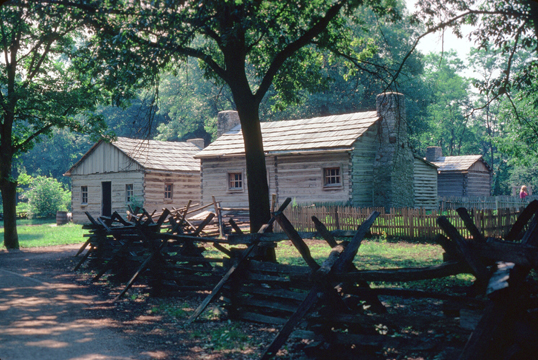 One of the Restored Houses in New Salem |
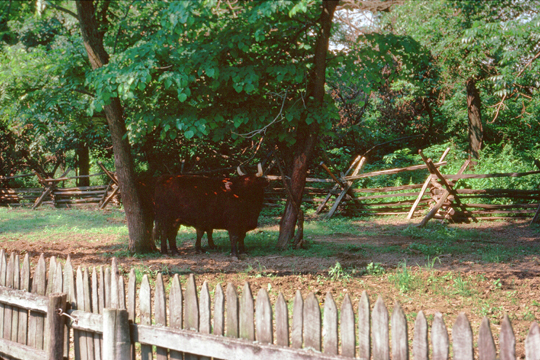 Livestock and Typical Split-Rail Fence |
When Lincoln lived in New Salem, the village was home to a cooper shop, blacksmith shop, wool carding mill, four general stores, a tavern, a grocery, two doctors' offices, a shoemaker, a carpenter, a hat maker, a tanner, a schoolhouse/church, several residences, common pastures, and kitchen gardens. During its short existence, the village was home to anywhere from 20 to 25 families at a time. New Salem was not a small farm village, but instead a commercial village full of young businessmen and craftsmen trying to start a new life on the frontier.
|
|
In 1906, William Randolph Hearst purchased the village land and deeded it to the Old Salem Chautauqua Association. In 1919, the land was gifted to the State of Illinois. The current village site was opened to the public in 1921, having been rebuilt on the foundations of the original village, mostly by the Civilian Conservation Corps, during the Great Depression. The location is presently called Lincoln's New Salem State Historic Site, featuring 23 buildings, mostly log cabins and costumed interpreters, representing the era of Lincoln's residency. The cabins, shops, and businesses are furnished by period implements, objects, and furniture, with many acquired from area farms and homes. In addition to the village, the 700-acre park includes extensive woodlands.
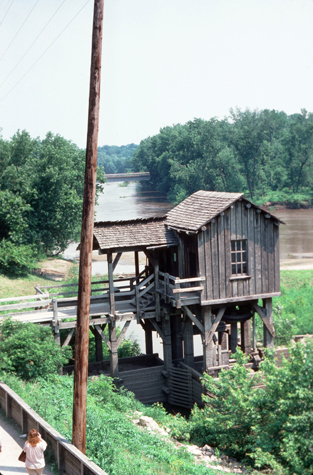 |
(Picture at left) This reconstructed building shows the mill where Abraham Lincoln worked when he moved to New Salem in July 1831. He had been hired by Denton Offutt, who rented the mill from village founders John Camron and James Rutledge.
(Picture at right)
|
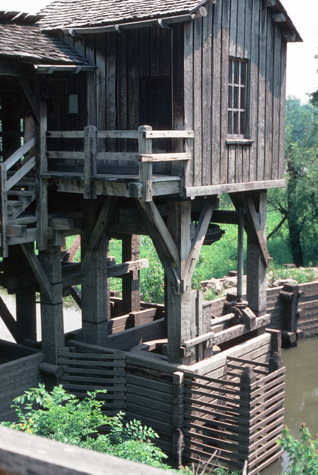 |
Twenty-two of the village buildings are reconstructed; one log cabin, the Onstot Cooper Shop, is original, although it had been previously moved by Henry Onstot to Petersburg in 1840. In 1922, it was returned to New Salem on what archeologists believe was its original foundation. In addition to archeological investigations, much of the town was recreated based on period documents and the recollections and drawings of former residents interviewed in the late 19th century.
|
In the summer of 1961, after a period of design and fabrication, a 73-foot, 40-ton, upper-cabin sternwheel steamboat made its way from Dubuque, Iowa to New Salem by way of the Mississippi River, Illinois River, and the Sangamon River. The steamer, christened the Talisman, was a scaled-down recreation of the original boat that ventured from Cincinnati, Ohio, down the Ohio River, up the Mississippi and Illinois Rivers, and into central Illinois on the Sangamon under the charter of Springfield businessman Vincent Bogue in 1832.
The original Talisman was actually a 136-foot, 150-ton steamer, and may or may not have been a sidewheel boat. Lincoln helped clear obstructions from the riverbanks on the Talisman's trip upriver, and co-piloted the steamer with Rowan Herndon back to Beardstown.
The recreation boat was given a landing next to the Rutledge Camron Saw and Grist Mill site on the riverbank, and tourists had the opportunity to take short excursions on the river. Unfortunately, just like the original Talisman, the recreated steamer was plagued by low water levels on the river which gradually diminished in the years following its arrival at New Salem.
(You might be interested to know, as I certainly was when creating some of the narrative for these pictures in the mid-1990s, that navigation on the Sangamon River got so difficult over the years that on one of its trips upriver it grounded, bringing to an end its service as a tourist attraction. I understand that the boat was left upriver, and that a private individual bought it and had it moved somewhere.)
|
|
I should have written off the car right then, but I had it repaired since I liked it so much. It never worked perfectly after that, and when I was involved in another fender bender about a month after the repairs, I figured somebody was trying to tell me something so I went and bought the nicest-looking car I could find- this Datsun 200SX. It had all the newfangled gadgets, including a voice that told you when the door was open or when you left your lights on. I like it a lot.
The entire park was extremely interesting, and we had a great time walking around. There were people doing hand crafts, exhibits to look at, and so on. It was a nice day, and we were going to stay at a country inn near the park that night.
|
Lincoln Home National Historic Site preserves the Springfield, Illinois home and a historic district where Abraham Lincoln lived from 1844 to 1861, before becoming the 16th President of the United States. The presidential memorial includes the four blocks surrounding the home (brown house in the background) and a visitor center (small white house in the foreground).
In 1837, Lincoln moved to Springfield from New Salem at the start of his law career. He met his wife, Mary Todd, at her sister's home in Springfield and married there in 1842. The historic-site house, purchased by Lincoln and his wife in 1844, was the only home that Lincoln ever owned, and all their children were born there. Located at the corner of Eighth and Jackson Streets, the house contains twelve rooms spread over two floors. During the time he lived here, Lincoln was elected to the House of Representatives in 1846, and elected President in 1860.
Lincoln's son, Robert Todd Lincoln donated the family home to the State of Illinois in 1887 under the condition that it would forever be well-maintained and open to the public at no charge. This came as a result of tenants who would charge those who wanted to visit Lincoln's home and that many tenants tended to leave the home in disrepair. The home and Lincoln Tomb, also in Springfield, were designated National Historic Landmarks in 1960, and listed on the National Register of Historic Places in 1966. The home and adjacent district became a National Historic Site in 1971.
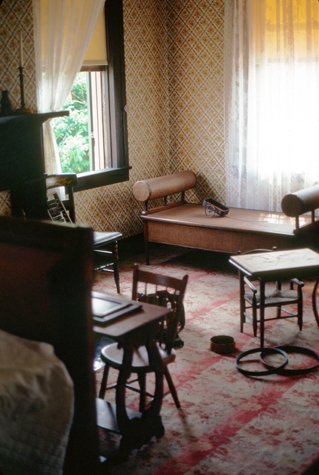 |
(Picture at left) Inside Lincoln's home, this is the study where Lincoln worked when he was a lawyer in Springfield.
(Picture at right)
|
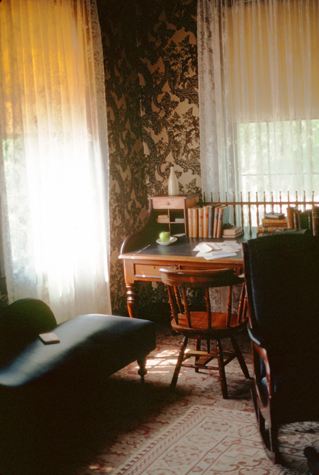 |
I enjoyed spending this weekend with Dennis here in Springfield; he was an excellent tour guide in showing me around, and I hope I'll get an invitation to make a return trip. My next week's assignment is in St. Louis, so I left after dinner on Sunday to drive the rest of the way down there.
You can use the links below to continue to another photo album page.
 |
July 3-10, 1982: A Week in Brighton, England |
 |
Return to the Index for 1982 |